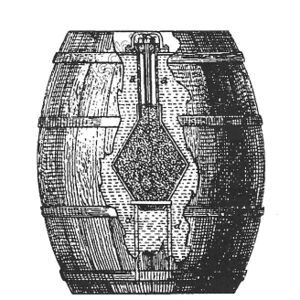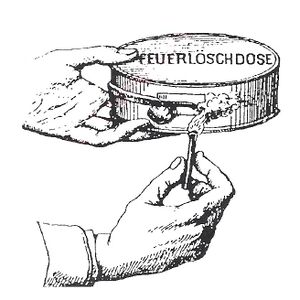Keeping Control
In the history of fire extinguishers, there have been some curious and important inventions. Developed as a response to many devastating fires, modern extinguishers have come a long way since their invention in 1715.
The first fire extinguisher (Q3612) was invented in 1715 by the German Zacharias Greyl. The device consisted of a wooden barrel filled with 20 litres of water and ignited with the help of black powder and a fuse. In case of fire, the fuse was lit, the device was thrown into the fire and the fire was extinguished with it.
About 100 years later, in 1816, the English captain George Manby invented what was perhaps the first fire extinguisher as we know it today. It contained 13 litres of potassium carbonate, a chemical that has been used in firefighting since the 18th century. The liquid was released by opening a tap, which was previously pressurised with compressed air.
The Fire Annihilator was patented by William Henry Phillips in 1844. The design was quite complicated, but basically chemicals were mixed inside the device, which ignited and caused a strong heat that turned the water inside into steam. This was released through nozzles on top of the fire extinguisher. The creator, however, could not convince anyone that it was a working device, as many demonstrations failed, and his factory was destroyed by a fault in the device.
In 1850 there was another ‘chemical’ fire extinguisher produced in Germany, by Heinrich Gottlieb Kühn: a small box filled with sulphur, saltpetre, coal and a small charge of gunpowder. It was to be ignited, thrown into fires and ‘extinguishing vapours’ created. These were then supposed to extinguish or smother the fire. In Chicago, an extinguishing grenade was invented in 1871. This was essentially just a glass container filled with a salt-water solution, to be thrown into the fire. Although the extinguishing effect was minimal, this grenade was produced throughout Europe until 1950.
In the meantime, Mr Schwartz of Bocholt developed the ‘patent hand fire extinguisher’ in 1884. It was filled with extinguishing powder (probably sodium bicarbonate). The contents had to be thrown into the fire by force. In 1902, the Graaff brothers developed the spray bag in Germany, which used pressure to force water out of the extinguisher. This was achieved with the help of a bottle of sulphuric acid which broke inside the device and reacted with the soda water.
In France, the Frenchman Alexandre Laurent developed the first foam-based fire extinguisher in 1906. In the event of a fire, two liquids were mixed in the extinguisher, which produced an extinguishing foam and then smothered the fire.
A few years later, the first carbon dioxide (CO2) extinguisher was invented in Germany. With the help of CO2 and a water-resistant powder, the fire was then extinguished.
Modern fire extinguishers have come a long way since their invention in 1715. Most are now manufactured as powder extinguishers with stored pressure or with CO2 cartridges. This design is essentially unchanged since the 1950s, but of course all components have been improved and reliability increased. Modern extinguishing powders are also rated according to specific fire classes and performance. There are five main types of fire, each of which must be handled and extinguished differently:
- A for solids (wood, paper, textiles, etc.)
- B for flammable liquids
- C for flammable gases
- D for flammable metals
- F for cooking oils and fats
Fires can involve electrical equipment, which also determines the correct type of extinguisher to use.
It is dangerous to use the incorrect type of extinguisher: water on liquids can cause a fire to spread, water on metals can cause a violent explosive reaction and water on grease can cause a grease explosion. However, the most common fire extinguishers are generally those with an ABC powder that is effective against most small fires.
Many of the first fire extinguishers were not only unsuitable and had too little effect, but were actually very dangerous. Today, experts state that 90% of fires can be extinguished with a fire extinguisher if discovered in time.



